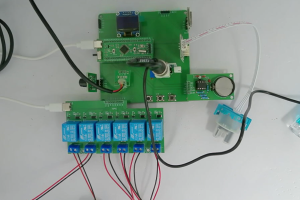设计说明书
总字数:22000+
摘要
在泳池管理中,水质与环境参数的精准监测和调控对保障游泳者健康、提升管理效率具有重要意义。传统的泳池管理方式依赖人工巡检和手动操作,不仅存在参数监测滞后、调控不及时的问题,还耗费大量人力,难以满足现代化泳池对自动化、智能化管理的需求。
基于 STM32F103C8T6 单片机的泳池环境监测系统,整合了防水式 DS18B20 温度传感器、DS1302 时钟模块、TSW-30 浑浊度检测模块、PH4502C 检测模块、人体热释电感应模块、3 个独立按键、OLED 显示屏、ESP8266WiFi 模块及执行设备(加热装置、抽水与放水水泵、消毒灯、加酸加碱装置等),实现了泳池环境的自动化监测与智能调控。系统核心功能包括:通过 DS18B20 测量水温,水温低于设置最小值时启动加热,直至达到最大值;借助 DS1302 获取时间,支持通过按键设置定时换水时间,由两个水泵分别执行抽水和放水;通过按键设置紫外线消毒时间,期间结合人体热释电感应模块,无人时开启消毒灯,有人时关闭;利用 TSW-30 检测浑浊度,过高时触发换水;通过 PH4502C 检测 PH 值,超限时自动加酸或加碱;支持通过按键修正时间、设置阈值及手动控制各继电器;通过 OLED 显示屏实时显示各项测量数据;借助 ESP8266WiFi 模块将数据远程发送至手机端,手机端可设置阈值并远程控制各继电器。
该系统的实现,有效提升了泳池环境管理的自动化与智能化水平,减少了人工干预,确保了水质参数的稳定与安全,为泳池运营提供了高效、可靠的解决方案,同时为同类水环境监测设备的研发提供了参考,具有较高的实际应用价值。
关键词:STM32F103C8T6;泳池环境;监测系统;传感器;智能调控;WiFi 通信
ABSTRACT
In swimming pool management, precise monitoring and regulation of water quality and environmental parameters are of great significance for ensuring swimmers’ health and improving management efficiency. Traditional swimming pool management methods rely on manual inspection and manual operation, which not only have problems of delayed parameter monitoring and untimely regulation but also consume a lot of manpower, making it difficult to meet the needs of modern swimming pools for automated and intelligent management.
The swimming pool environment monitoring system based on the STM32F103C8T6 microcontroller integrates waterproof DS18B20 temperature sensors, DS1302 clock modules, TSW-30 turbidity detection modules, PH4502C detection modules, human body pyroelectric induction modules, 3 independent buttons, OLED displays, ESP8266WiFi modules, and executive devices (heating devices, water pumping and draining pumps, disinfection lamps, acid and alkali adding devices, etc.), realizing automatic monitoring and intelligent regulation of the swimming pool environment. The core functions of the system include: measuring water temperature through DS18B20, starting heating when the water temperature is lower than the set minimum value until it reaches the maximum value; obtaining time with the help of DS1302, supporting setting 定时 water change time through buttons, with two pumps performing water pumping and draining respectively; setting ultraviolet disinfection time through buttons, and during this period, combined with the human body pyroelectric induction module, turning on the disinfection lamp when no one is present and turning it off when someone is present; using TSW-30 to detect turbidity, triggering water change when it is too high; detecting PH value through PH4502C, automatically adding acid or alkali when exceeding the limit; supporting time correction, threshold setting and manual control of each relay through buttons; real-time display of various measurement data through OLED display; sending data remotely to the mobile phone through ESP8266WiFi module, and the mobile phone can set thresholds and remotely control each relay.
The implementation of this system effectively improves the automation and intelligence level of swimming pool environment management, reduces manual intervention, ensures the stability and safety of water quality parameters, provides an efficient and reliable solution for swimming pool operation, and also offers a reference for the research and development of similar water environment monitoring equipment, with high practical application value.
Keywords: STM32F103C8T6; Swimming pool environment; Monitoring system; Sensor; Intelligent regulation; WiFi communication
目录
第 1 章 绪论
1.1 研究的目的及意义
1.2 国内外发展情况
1.3 本文主要研究内容
第2章 设计思路与方案论证
2.1 主要元器件选择
2.1.1 主控芯片选择
2.1.2 温度传感器选择
2.1.3 时钟模块选择
2.1.4 浑浊度检测模块选择
2.1.5 PH 检测模块选择
2.1.6 人体热释电感应模块选择
2.1.7 按键模块选择
2.1.8 显示模块选择
2.1.9 WiFi 模块选择
2.2整体设计方案
第 3 章 硬件设计
3.1 主控电路模块
3.2 温度传感器电路
3.3 时钟模块电路
3.4 浑浊度检测模块电路
3.5 PH 检测模块电路
3.6 人体热释电感应模块电路
3.7 按键模块电路
3.8 显示模块电路
3.9 WiFi 模块电路
3.10 执行设备驱动电路
第4章 系统程序设计
4.1 编程软件介绍
4.2 系统主流程设计
4.3 独立按键
4.4 OLED显示流程设计
4.5 温度检测模块子流程设计
4.6 时钟模块子流程设计
4.7 WiFi模块子流程设计
第 5 章 实物测试
5.1 整体实物测试
5.2 温度传感器功能测试
5.3 时钟模块功能测试
5.4 浑浊度检测模块功能测试
5.5 PH 检测模块功能测试
5.6 人体热释电感应模块功能测试
5.7 按键功能测试
5.8 显示模块功能测试
5.9 WiFi 模块功能测试
第 6 章 总结与展望
6.1 总结
6.2 展望
致谢
参考文献
附录
附录一:原理图
附录二:PCB
附录三:主程序
购买后可查看具体内容!

